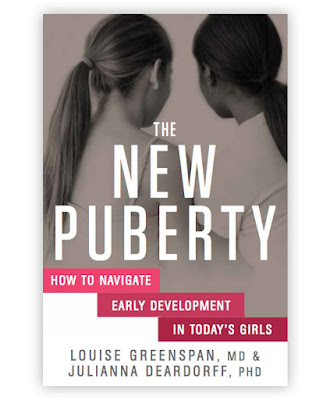The New Puberty
 |
| The Book" The new puberty" |
This article is based on TEDMED talk 2015 in Palm Springs,
California by Pediatric endocrinologist Louise Greenspan and her groundbreaking
book, -“The New Puberty: How To Navigate Early
Development in Today’s Girls”, along with coauthor Julianna Deardorff, a
Berkeley professor of Maternal and Child Health and adolescent psychologist.
Just a generation ago, fewer than 5 percent of girls started
puberty before the age of 8, today girls are entering
puberty at increasingly younger ages with 10% of girls now showing the first
signs of puberty before age 8.
Early puberty can lead to eating
disorders, depression, substance abuse,
early sexual activity and, later in life, breast cancer.
According to Dr. Greenspan, two important culprits
responsible are obesity and
family stress.
"We used to say that breast development and pubic hair
should not start before age 8. What we know now is that 15% of girls at age 7
are showing breast development," Dr Greenspan reported.
According to Biro.F.M
et al in Pediatrics 2013;132:1019-1027
Girls from racial and ethnic groups with the highest rates of obesity are most
at risk for early puberty. In that study, black girls showed breast budding at
an average age of 8.75 years, Hispanic girls at an average age of 9.25 years,
and white and Asian girls at an average age of 9.75 years.
Higher BMI was the strongest predictor of earlier age at
breast stage 2 in this study
The relationship between higher BMI and earlier onset of
puberty in girls has been noted previously; in 2 large cross-sectional studies,
Pediatric Research in Office Settings (PROS) and the National Health and
Nutrition Examination Survey (NHANES) III, earlier maturation occurred in those
girls with greater BMI and in those with BMI ≥85th percentile.
Body fat makes estrogens, which are the same kind of hormone
that are normally released from the ovaries during puberty. When there is more
body fat, there are higher levels of estrogen, which leads to breast budding.
In USA
the rate of obesity in children aged 6 to 11 years of age increased from 7% in
1980 to nearly 18% in 2012, according to a report from
the Centers for Disease Control and Prevention.
And during the same period, the rate of adolescents 12 to 19
years of age who were obese increased from 5% to nearly 21%.
The trend is not just seen in the U.S., it's seen in multiple
countries, probably more so countries closer to the equator than countries in
the northern latitudes. But major factor is likely to be, certainly in the
developing countries, a switch from a more traditional diet to a more Western
diet, which results in greater, perhaps better nutrition or perhaps
over-nutrition, and that's certainly a factor.
Stress is the second important factor in causing early puberty;
other risk factors are early sexual abuse and toxic levels of family arguments
and neighborhood violence.
Dr Greenspan says that “Most notably, a girl who grows up
without her biological father is twice as likely to get her period before age
12 as a girl who lives with her biological father.”
She does not refute the endocrine-disrupting chemicals
commonly found in plastics and pesticides for early puberty, but it is almost
impossible to eliminate endocrine-disrupting chemicals from our environment,
and there is no single smoking gun, she explained.
These chemicals can mimic hormones in the body, and some
mimic hormones that are important regulators of puberty, particularly estrogen.
However, more research is needed on humans.
She noted that "a much more effective public health
intervention would be to try to tame the obesity epidemic and put some greater
social infrastructure in place to buffer children from the stresses of
poverty."
The authors offer highly practical strategies that can help
prevent and manage early puberty including limiting exposure to certain
ingredients in personal care and household products, which foods to eat and
which to avoid, and ways to improve a child’s sleep routine to promote healthy
biology.
Moreover, the authors—both mothers of young girls—offer
parents, teachers, coaches, and caretakers guidance to initiate and continue
the conversation about puberty in an age-appropriate way to support girls as
they navigate this complex stage of their lives.
References:
No comments:
Post a Comment